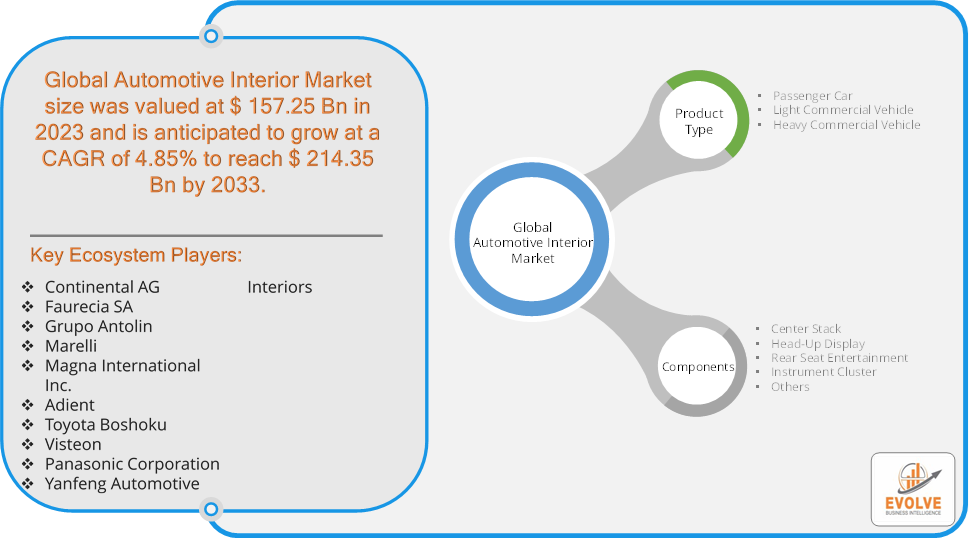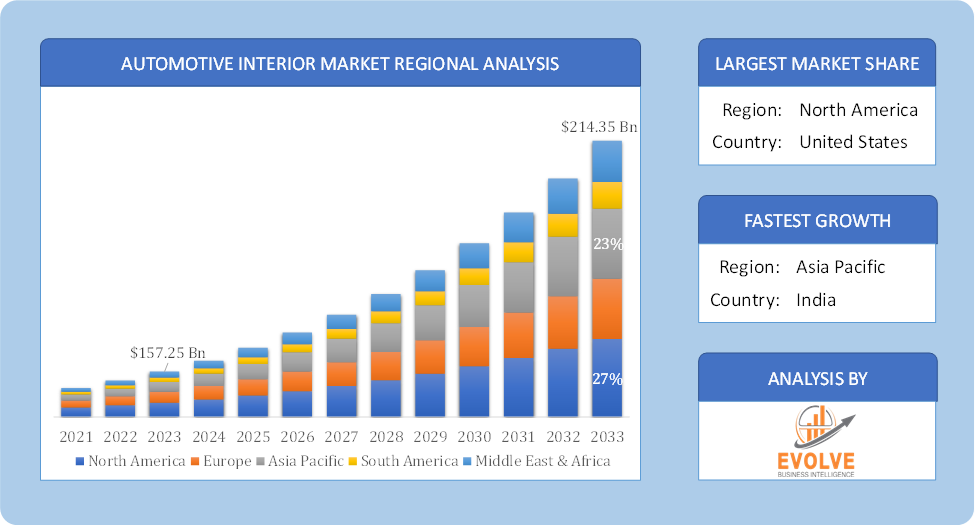Automotive Interior Market Overview
The Automotive Interior Market Size is expected to reach USD 214.35 Billion by 2033. The Automotive Interior Market industry size accounted for USD 157.25 Billion in 2023 and is expected to expand at a compound annual growth rate (CAGR) of 4.85% from 2023 to 2033. The Automotive Interior Market refers to the industry segment that involves the production, distribution, and sales of components and systems used inside vehicles. This includes a wide range of products designed to enhance the comfort, aesthetics, safety, and functionality of a vehicle’s interior.
The market is influenced by factors such as consumer preferences for comfort and luxury, advancements in materials and technologies, regulatory requirements for safety, and trends towards connected and smart vehicle interiors.
Global Automotive Interior Market Synopsis
 COVID-19 Impact Analysis
COVID-19 Impact Analysis
The COVID-19 pandemic had a significant impact on the Automotive Interior Market. The pandemic caused major disruptions in the global supply chain. Many automotive interior component manufacturers faced delays due to factory shutdowns, restrictions on transportation, and shortages of raw materials. This affected the production schedules and delivery timelines of interior components. The pandemic increased consumer awareness and demand for health and hygiene features in vehicles. This led to the development and integration of new interior materials and technologies that are easy to clean and have antimicrobial properties. The economic downturn resulted in budget constraints for both consumers and manufacturers. Consumers became more cost-conscious, leading to a preference for vehicles with essential features rather than luxury interiors. Manufacturers faced financial challenges, impacting their investment in research and development for new interior technologies. The pandemic also highlighted the importance of sustainability. There was an increased focus on using eco-friendly materials and sustainable manufacturing practices in automotive interiors to meet consumer and regulatory demands.
Automotive Interior Market Dynamics
The major factors that have impacted the growth of Automotive Interior Market are as follows:
Drivers:
Ø Technological Advancements
Innovations in automotive technology, such as advanced infotainment systems, smart touch panels, heads-up displays, and connected car features, are major drivers. These technologies enhance the driving experience and increase the appeal of modern vehicle interiors. Growing environmental awareness is pushing automakers to use sustainable and eco-friendly materials in vehicle interiors. This includes recycled materials, natural fibers, and low-emission manufacturing processes. Urbanization and changing mobility patterns are influencing the design of automotive interiors. The demand for compact and efficient interior designs is increasing, especially in densely populated urban areas.
Restraint:
- Perception of High Cost of Advanced Technologies and Fluctuating Raw Material Prices
The integration of advanced technologies such as infotainment systems, smart touch panels, and advanced safety features can significantly increase the overall cost of the vehicle. This may limit the adoption of such features, especially in cost-sensitive markets. The prices of raw materials used in automotive interiors, such as plastics, textiles, leather, and metals, can be volatile. Fluctuations in raw material prices can affect the profitability of manufacturers and lead to increased costs for consumers.
Opportunity:
⮚ Electrification and Autonomous Vehicles
The shift towards electric vehicles (EVs) and the development of autonomous driving technologies present significant opportunities for innovative interior designs. These vehicles often feature unique layouts, enhanced infotainment systems, and reconfigurable seating arrangements to provide a better user experience. The use of AR and VR technologies in automotive interiors can create immersive experiences for passengers. As safety remains a top priority for consumers, there are opportunities to develop and integrate advanced safety features within vehicle interiors. This includes technologies such as advanced driver-assistance systems (ADAS), smart airbags, and collision detection systems.
Automotive Interior Market Segment Overview
 By Product Type
By Product Type
Based on Product Type, the market is segmented based on Passenger Car, Light Commercial Vehicle and Heavy Commercial Vehicle. The passenger car segment dominant the market. The number of passenger cars is rising because of rising populations, more disposable income, and urbanization. Manufacturers typically create more effective braking systems to add more safety features. The primary market share and growth of the passenger car are primarily influenced by the ADAS. Due to an increase in the demand for electromagnetic induction braking systems in cars, motorcycles, and other vehicles over the forecast period, rising ADAS spending is also anticipated to impact the brake systems market.
By Components
Based on Components, the market segment has been divided into Center Stack, Head-Up Display, Rear Seat Entertainment, Instrument Cluster and Others. The Rear Seat Entertainment segment dominant the market. The growing market for luxury and premium vehicles boosts the demand for advanced rear-seat entertainment systems. These systems are aimed at enhancing passenger comfort and entertainment, especially during long journeys.
Global Automotive Interior Market Regional Analysis
Based on region, the global Automotive Interior Market has been divided into North America, Europe, Asia-Pacific, the Middle East & Africa, and Latin America. North America is projected to dominate the use of the Automotive Interior Market followed by the Asia-Pacific and Europe regions.
 Automotive Interior North America Market
Automotive Interior North America Market
North America holds a dominant position in the Automotive Interior Market. It has high adoption of advanced infotainment systems, connected car technologies, and smart touch panels. Strong demand for luxury and premium vehicle interiors and increasing interest in health and wellness features, such as air purification systems and ergonomic seating. Increasing demand for seamless connectivity and advanced infotainment options and rising consumer awareness of health and hygiene, driving demand for antimicrobial materials and air quality control systems.
Automotive Interior Asia-Pacific Market
The Asia-Pacific region has indeed emerged as the fastest-growing market for the Automotive Interior Market industry. It having strong growth in vehicle production and sales, driven by increasing disposable incomes and a rising middle class. Rising interest in modern, comfortable, and feature-rich vehicle interiors and rapid urbanization and increasing disposable incomes in countries like China and India are driving demand for new vehicles with advanced interiors and focus on cost-effective solutions and emerging markets.
Competitive Landscape
The global Automotive Interior Market is highly competitive, with numerous players offering a wide range of software solutions. The competitive landscape is characterized by the presence of established companies, as well as emerging startups and niche players. To increase their market position and attract a wide consumer base, the businesses are employing various strategies, such as product launches, and strategic alliances.
Prominent Players:
- Continental AG
- Faurecia SA
- Grupo Antolin
- Marelli
- Magna International Inc.
- Adient
- Toyota Boshoku
- Visteon
- Panasonic Corporation
- Yanfeng Automotive Interiors
Scope of the Report
Global Automotive Interior Market, by Product Type
- Passenger Car
- Light Commercial Vehicle
- Heavy Commercial Vehicle
Global Automotive Interior Market, by Components
- Center Stack
- Head-Up Display
- Rear Seat Entertainment
- Instrument Cluster
- Others
Global Automotive Interior Market, by Region
- North America
- US
- Canada
- Mexico
- Europe
- UK
- Germany
- France
- Italy
- Spain
- Benelux
- Nordic
- Rest of Europe
- Asia Pacific
- China
- Japan
- South Korea
- Indonesia
- Austalia
- Malaysia
- India
- Rest of Asia Pacific
- South America
- Brazil
- Argentina
- Rest of South America
- Middle East & Africa
- Saudi Arabia
- UAE
- Egypt
- South Africa
- Rest of Middle East & Africa
| Parameters | Indicators |
|---|---|
| Market Size | 2033: USD 214.35 Billion |
| CAGR (2023-2033) | 4.85% |
| Base year | 2022 |
| Forecast Period | 2023-2033 |
| Historical Data | 2021 (2017 to 2020 On Demand) |
| Report Coverage | Revenue Forecast, Competitive Landscape, Growth Factors, and Trends |
| Key Segmentations | Product Type, Components |
| Geographies Covered | North America, Europe, Asia-Pacific, South America, Middle East, Africa |
| Key Vendors | Continental AG, Faurecia SA, Grupo Antolin, Marelli, Magna International Inc., Adient, Toyota Boshoku, Visteon, Panasonic Corporation and Yanfeng Automotive Interiors. |
| Key Market Opportunities | · Electrification and Autonomous Vehicles
· Integration of Augmented Reality (AR) and Virtual Reality (VR) |
| Key Market Drivers | · Technological Advancements
· Urbanization and Mobility Trends |
REPORT CONTENT BRIEF:
- High-level analysis of the current and future Automotive Interior Market trends and opportunities
- Detailed analysis of current market drivers, restraining factors, and opportunities in the future
- Automotive Interior Market historical market size for the year 2021, and forecast from 2023 to 2033
- Automotive Interior Market share analysis at each product level
- Competitor analysis with detailed insight into its product segment, Government & Defense strength, and strategies adopted.
- Identifies key strategies adopted including product launches and developments, mergers and acquisitions, joint ventures, collaborations, and partnerships as well as funding taken and investment done, among others.
- To identify and understand the various factors involved in the global Automotive Interior Market affected by the pandemic
- To provide a detailed insight into the major companies operating in the market. The profiling will include the Government & Defense health of the company’s past 2-3 years with segmental and regional revenue breakup, product offering, recent developments, SWOT analysis, and key strategies.


 Automotive Interior North America Market
Automotive Interior North America Market




